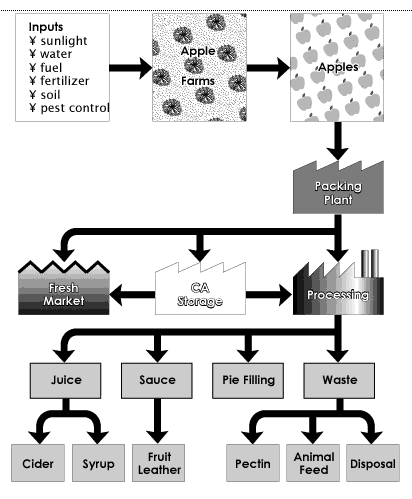Course:FNH200/Lessons/Lesson 01/Page 01.5
01.5 Apples and Apple Products
The processing of apples will be used as an example of the utilization and conversion of an agricultural commodity to various food products and ingredients (Fig. 1.2). After harvesting, apples can be routed several directions: they can be shipped directly to the fresh market; they can be processed; or they can be put into controlled atmosphere storage facilities where the atmosphere, temperature and humidity are carefully controlled to retard the rate of respiration and ripening of the apples, thus extending the storage life of the fresh fruit. Controlled atmosphere storage of apples is described at:
- http://www.omafra.gov.on.ca/english/crops/facts/12-045.htm
Apples can be processed in various ways. A large proportion of processing apples is converted to apple juice. The type of apple juice preferred by consumers in Western Canada is the clear apple juice. Apple juice can be used as the starting material for the production of apple cider. In making cider, apple juice is inoculated with specific yeast strains which ferment sugar in the juice into ethanol and produce flavours characteristic of apple cider. Apple cider can be further processed by inoculating it with a bacterial culture that will oxidize the ethanol to acetic acid to produce apple vinegar.
The apple solids remaining after juice extraction can be used as a feed material for the production of pectin (a carbohydrate used as gelling agent in the production of jams and jellies), animal feed, or as organic matter that can be returned to agricultural lands. In some cases, the residue may also be trucked to landfill sites which adds to the waste burden entering those sites.
Apples are also processed into apple sauce and pie fillings. A greater proportion of these products are used as ingredients in the bakery and food service industries than as items in retail stores.
To a lesser extent, apples are used to produce dehydrated apple slices, fruit leather, apple-filled snack bars and as ingredients for some confectionary products and breakfast cereals.
| Figure 1.2 Apple production and processing |
| Want to learn more? |
|
